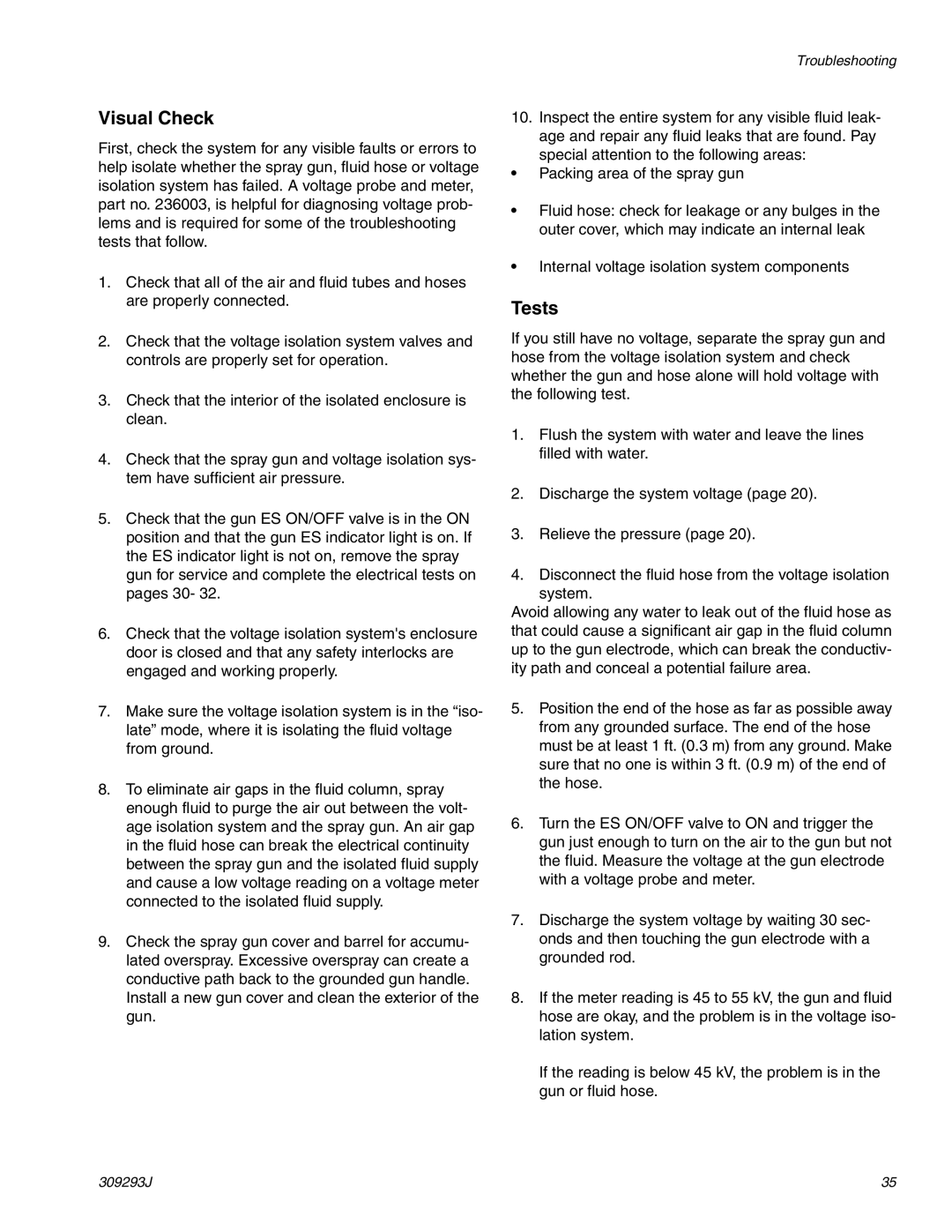Visual Check
First, check the system for any visible faults or errors to help isolate whether the spray gun, fluid hose or voltage isolation system has failed. A voltage probe and meter, part no. 236003, is helpful for diagnosing voltage prob- lems and is required for some of the troubleshooting tests that follow.
1.Check that all of the air and fluid tubes and hoses are properly connected.
2.Check that the voltage isolation system valves and controls are properly set for operation.
3.Check that the interior of the isolated enclosure is clean.
4.Check that the spray gun and voltage isolation sys- tem have sufficient air pressure.
5.Check that the gun ES ON/OFF valve is in the ON position and that the gun ES indicator light is on. If the ES indicator light is not on, remove the spray gun for service and complete the electrical tests on pages 30- 32.
6.Check that the voltage isolation system's enclosure door is closed and that any safety interlocks are engaged and working properly.
7.Make sure the voltage isolation system is in the “iso- late” mode, where it is isolating the fluid voltage from ground.
8.To eliminate air gaps in the fluid column, spray enough fluid to purge the air out between the volt- age isolation system and the spray gun. An air gap in the fluid hose can break the electrical continuity between the spray gun and the isolated fluid supply and cause a low voltage reading on a voltage meter connected to the isolated fluid supply.
9.Check the spray gun cover and barrel for accumu- lated overspray. Excessive overspray can create a conductive path back to the grounded gun handle.
Install a new gun cover and clean the exterior of the gun.
Troubleshooting
10. Inspect the entire system for any visible fluid leak- age and repair any fluid leaks that are found. Pay special attention to the following areas:
•Packing area of the spray gun
•Fluid hose: check for leakage or any bulges in the outer cover, which may indicate an internal leak
•Internal voltage isolation system components
Tests
If you still have no voltage, separate the spray gun and hose from the voltage isolation system and check whether the gun and hose alone will hold voltage with the following test.
1.Flush the system with water and leave the lines filled with water.
2.Discharge the system voltage (page 20).
3.Relieve the pressure (page 20).
4.Disconnect the fluid hose from the voltage isolation system.
Avoid allowing any water to leak out of the fluid hose as that could cause a significant air gap in the fluid column up to the gun electrode, which can break the conductiv- ity path and conceal a potential failure area.
5.Position the end of the hose as far as possible away from any grounded surface. The end of the hose must be at least 1 ft. (0.3 m) from any ground. Make sure that no one is within 3 ft. (0.9 m) of the end of the hose.
6.Turn the ES ON/OFF valve to ON and trigger the gun just enough to turn on the air to the gun but not the fluid. Measure the voltage at the gun electrode with a voltage probe and meter.
7.Discharge the system voltage by waiting 30 sec- onds and then touching the gun electrode with a grounded rod.
8.If the meter reading is 45 to 55 kV, the gun and fluid hose are okay, and the problem is in the voltage iso- lation system.
If the reading is below 45 kV, the problem is in the gun or fluid hose.
309293J | 35 |
